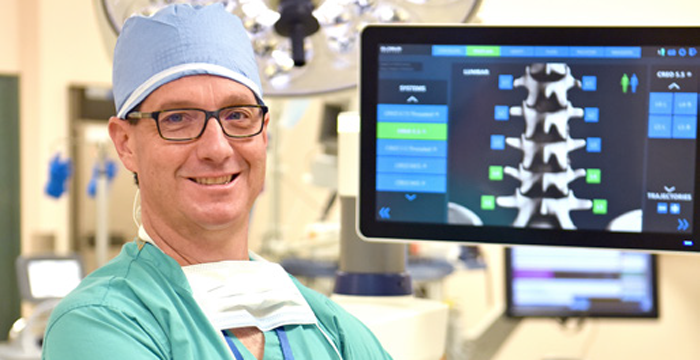-
Services
Featured Specialties
-
Locations
Location Type
-
Patients & Visitors
Ellen Chandler is no stranger to Lawrence + Memorial Hospital. Born and raised in New London, she graduated from L+M’s Nursing Education Program (formerly Joseph Lawrence) in 1971 and began working as a registered nurse for 30 years. Little did she know she’d be on the receiving end of care at L+M with the use of advanced robotics technology nearly 50 years later.
“The nastiest thing was the constant burning on my lower spine,” recalled Chandler of her persistent and life-altering back pain. Affable and active, she slowly began scaling back her activities. “I dropped out of things one by one—I dropped out of bowling. Then I dropped out of golf. I would also go to the Waterford High School pool and do an aqua fitness class. The last thing to go was my strength and conditioning class at the community center twice a week.”

When an MRI determined that she needed to see a neurosurgeon, Chandler chose Patrick Doherty, MD, chief of Yale Medicine Neurosurgery at L+M. She was familiar with his work through family members who were patients of his, and from word-of-mouth recommendations around town. She also attended an L+M Community Wellness Series presentation by Dr. Doherty titled, “An Integrated Approach to Spine Care.”
Upon consulting with Dr. Doherty, Chandler was diagnosed with lumbar spondylolisthesis in which a part of the spine is not stable, as well as degenerative disc disease in which vertebrae discs begin to deteriorate over time. These conditions can be caused by aging and normal wear and tear on the body.
“Ellen required a lumbar fusion for decompression and stabilization of the unstable segment, which was causing significant back pain when she moved,” explained Dr. Doherty, who performed Chandler’s surgery with the assistance of a robotic arm using ExcelsiusGPS® by Globus Medical. “This tool allows me to fuse the spine with greater accuracy, greater safety, less radiation and less risk,” said Dr. Doherty.

Designed by surgeons, ExcelsiusGPS combines the most advanced imaging and navigation system available today for spine procedures. Medical images uploaded to the system allow the surgeon to precisely plan incisions and the size and placement of implants based on each patient’s anatomy. The surgical plan guides the robotic arm to the specific region of the spine. The imaging technology displays the planned pathway for the surgeon’s instruments and shows every detail in real time throughout the procedure.
Chandler was surprised by the intricacies of the robotics technology involved in her surgery. “I didn’t know they were even using robots for back surgery. In the office, they showed me what they were going to do — and it was kind of delicate to move into these spaces, and then to have the nerves monitored, too; it was great.”
“This technology has taken our capabilities to the next level. We were safe and accurate before, but now we have nearly 100 percent accuracy in surgery with less tissue disruption. This means a faster recovery and faster return to work and life. We are already seeing a decline in the length of time required to be in the hospital after surgery,” said Dr. Doherty.
Chandler is thrilled about her recovery. After completing post-surgery physical therapy, she plans to resume all activities she was forced to give up. Before her November 2019 surgery, “I told (Dr. Doherty) I had to be up and moving by Christmas Eve because that’s my annual dinner for all of my family — and I was.”
*This article was written before the coronavirus pandemic.
ExcelsiusGPS® is a trademark of Globus Medical Inc.